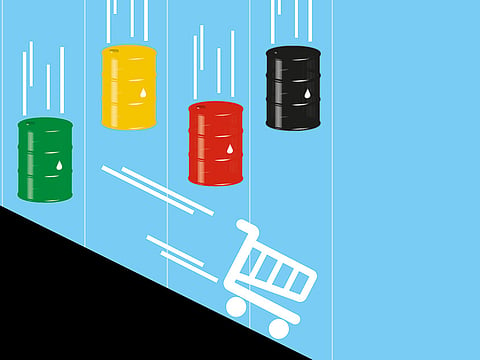Be very worried about the commodity slip ups
The recent price volatility impact will not be limited to their industries

By almost any measure last week was a bad one for commodities, as practically every part of the market lost value. West Texas Intermediate crude oil fell under $44 (Dh161.48) per barrel, Brent crude broke below $50 per barrel and copper tested $5,500 per metric tonne.
In China, coal and iron ore tumbled. Gold, the supposed ultimate haven, dropped to almost $1,225 per ounce.
Last week’s purge capped a steady decline in prices since mid-April and, more broadly, since February. Although much of the blame is being tied to rather high and growing inventory levels, a lack of real demand shouldn’t be discounted.
The market is experiencing something greater than a technical correction or speculative positioning. It is signalling something ominous about the state of the global economy. So while Friday (May 5) saw a small recovery, it appears to be merely a “dead cat bounce” rather than a sign of any market bottom.
Traders have reason to question global economic strength. They are concerned about fresh signs of an over-extended Chinese economy and an ongoing slowdown in developed markets faced with ageing demographics. In the US, they question President Donald Trump’s infrastructure promises along with his administration’s relaxed standards in the mining and drilling sectors, whose commodities we already have too much of.
Commodity producing nations
Opec’s output cuts have failed to do enough to stymie the global oil glut as US drillers add to their rig counts. Such negative sentiment has carried through in the equity markets, particularly among commodity-producing nations such as Australia, Canada and Brazil.
One could say the writing was on the wall. The world has become more efficient both in commodity production and consumption over the last few decades. As a result of better technology, it costs less today to produce many commodities than it did even a few years ago.
In energy, horizontal fracking provides much greater output then ever imagined when we were drilling straight down into the earth’s surface. Today, workers will venture 2.5 miles deep to extract from a 30-inch wide vein of gold-rich ore.
The world’s deepest oil well, known as Z-44 Chayvo in Russia’s Far East, extends over 40,000 feet into the ground — equal to 15 of the world’s tallest skyscraper, the Burj Khalifa, stacked on top of each other. Industrialised farming is yielding crops faster and larger than ever while utilising less land.
Drones can now provide detailed soil and crop conditions, eliminating the need for manual surveyors. A plump, juicy 3.5-pound chicken gets to market in 47 days from the date it was hatched.
Plastics and synthetics
On the consumption side, energy usage has dropped as office buildings, homes and appliances become more efficient. We utilise energy from sunlight, wind, ocean waves and biomass without having to drill for it.
Vehicles are lighter, as are beverage cans, requiring less metal inputs, while functionally better than previous models. Plastics and synthetics are replacing commodities such as base metals and rubber in automobiles and construction.
Finally, our ability to recycle has increased substantially as we aim to close the loop in what’s referred to as the “circular economy.”
Thus, even in a world where the population increases daily, it still makes sense that commodity prices are falling. Yes, a manufacturing company should be pleased if its input costs and the energy required in its processes have both dropped.
But what if it had previously entered into one or multiple-year physical commodity contracts with its suppliers, locking in prices at higher levels than those of today? Or perhaps that same company hedged its raw material needs with commodity futures, or derivatives in the belief that future prices would rally, only to now realise they were wrong. This is a common scenario even among some of the biggest industrials and manufacturers.
Lower commodity prices
Consider an industry that isn’t a heavy consumer of commodities, such as financial services.
Why should it care? Granted, these firms have to power up their buildings and branches, but overall, their energy expenses are small relative to those of human and technology resources. Nevertheless, they do care and should, because they most likely have a solid client base that is negatively affected by lower commodity prices, such as miners, energy producers and farmers.
And their clients suffer as their credit ratings are downgraded and they cut back on financial services.
Lower commodity prices are indicative of an economy that is slowing, and portend a domino effect that negatively impacts the broader capital markets.
Now is the time to question the assumptions behind the rosier economic forecasts — are they real and where are they coming from and can they be sustained under the current landscape of too much supply and insufficient demand?
The writer is an investment adviser and environmental sustainability consultant.
Sign up for the Daily Briefing
Get the latest news and updates straight to your inbox



